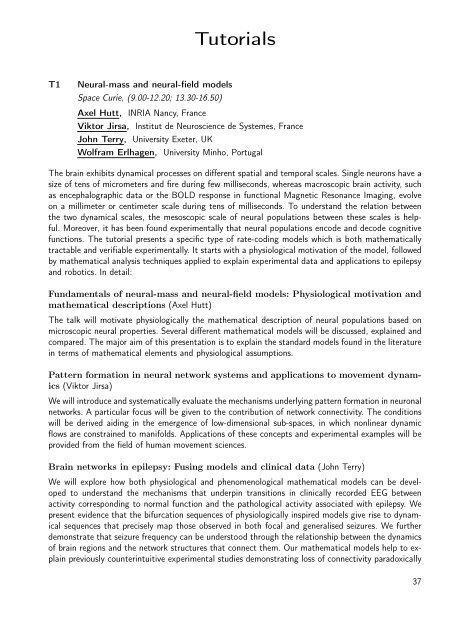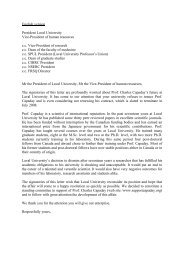Untitled - Laboratory of Neurophysics and Physiology
Untitled - Laboratory of Neurophysics and Physiology
Untitled - Laboratory of Neurophysics and Physiology
You also want an ePaper? Increase the reach of your titles
YUMPU automatically turns print PDFs into web optimized ePapers that Google loves.
Tutorials<br />
T1<br />
Neural-mass <strong>and</strong> neural-field models<br />
Space Curie, (9.00-12.20; 13.30-16.50)<br />
Axel Hutt, INRIA Nancy, France<br />
Viktor Jirsa, Institut de Neuroscience de Systemes, France<br />
John Terry, University Exeter, UK<br />
Wolfram Erlhagen, University Minho, Portugal<br />
The brain exhibits dynamical processes on different spatial <strong>and</strong> temporal scales. Single neurons have a<br />
size <strong>of</strong> tens <strong>of</strong> micrometers <strong>and</strong> fire during few milliseconds, whereas macroscopic brain activity, such<br />
as encephalographic data or the BOLD response in functional Magnetic Resonance Imaging, evolve<br />
on a millimeter or centimeter scale during tens <strong>of</strong> milliseconds. To underst<strong>and</strong> the relation between<br />
the two dynamical scales, the mesoscopic scale <strong>of</strong> neural populations between these scales is helpful.<br />
Moreover, it has been found experimentally that neural populations encode <strong>and</strong> decode cognitive<br />
functions. The tutorial presents a specific type <strong>of</strong> rate-coding models which is both mathematically<br />
tractable <strong>and</strong> verifiable experimentally. It starts with a physiological motivation <strong>of</strong> the model, followed<br />
by mathematical analysis techniques applied to explain experimental data <strong>and</strong> applications to epilepsy<br />
<strong>and</strong> robotics. In detail:<br />
Fundamentals <strong>of</strong> neural-mass <strong>and</strong> neural-field models: Physiological motivation <strong>and</strong><br />
mathematical descriptions (Axel Hutt)<br />
The talk will motivate physiologically the mathematical description <strong>of</strong> neural populations based on<br />
microscopic neural properties. Several different mathematical models will be discussed, explained <strong>and</strong><br />
compared. The major aim <strong>of</strong> this presentation is to explain the st<strong>and</strong>ard models found in the literature<br />
in terms <strong>of</strong> mathematical elements <strong>and</strong> physiological assumptions.<br />
Pattern formation in neural network systems <strong>and</strong> applications to movement dynamics<br />
(Viktor Jirsa)<br />
We will introduce <strong>and</strong> systematically evaluate the mechanisms underlying pattern formation in neuronal<br />
networks. A particular focus will be given to the contribution <strong>of</strong> network connectivity. The conditions<br />
will be derived aiding in the emergence <strong>of</strong> low-dimensional sub-spaces, in which nonlinear dynamic<br />
flows are constrained to manifolds. Applications <strong>of</strong> these concepts <strong>and</strong> experimental examples will be<br />
provided from the field <strong>of</strong> human movement sciences.<br />
Brain networks in epilepsy: Fusing models <strong>and</strong> clinical data (John Terry)<br />
We will explore how both physiological <strong>and</strong> phenomenological mathematical models can be developed<br />
to underst<strong>and</strong> the mechanisms that underpin transitions in clinically recorded EEG between<br />
activity corresponding to normal function <strong>and</strong> the pathological activity associated with epilepsy. We<br />
present evidence that the bifurcation sequences <strong>of</strong> physiologically inspired models give rise to dynamical<br />
sequences that precisely map those observed in both focal <strong>and</strong> generalised seizures. We further<br />
demonstrate that seizure frequency can be understood through the relationship between the dynamics<br />
<strong>of</strong> brain regions <strong>and</strong> the network structures that connect them. Our mathematical models help to explain<br />
previously counterintuitive experimental studies demonstrating loss <strong>of</strong> connectivity paradoxically<br />
37



